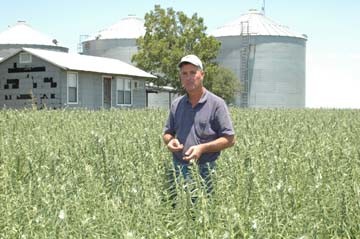‘Open sesame’ has new meaning for Cost farm
Look at Brian Fink’s hand, and his thumb doesn’t appear any greener than those of other Gonzales County farmers.
Look at his crops during the second worst drought in Texas history, and his plants are surprisingly greener than those of his peers.
Look closer at what Brian’s growing on his farm just west of Cost, and you’ll notice something very different for south central Texas.
It’s sesame.
Not like “open sesame” from Ali Baba and the Arabian Nights lore, but like what’s commonly found perched atop a hamburger bun.
For Brian, a 1980 graduate of Texas A&M University with a degree in agricultural economics who farmed with his dad William for decades, growing a crop that many might think has very little practical use apart from a fast-food entrée, the decision to plow virgin soil, metaphorically speaking, was one made at an opportune time.
For years, the Fink farm grew pretty much what everyone else in this part of the world grows: corn, milo and wheat.
Then came the San Antonio International Farm & Ranch Show.
“I came upon it at the San Antonio farm show,” Brian says matter of factly about the crop that just may change farming throughout the heart of Texas.
The good thing is, because of his history in corn and milo, Brian already had the equipment needed for planting and harvesting the tiny sesame seeds.
So he signed up with genetic developer, processor and marketer SESACO to be a sesame farmer.
“It’s the first year for me; I’m still learning,” Brian admits. “I’m hoping it works out.”
He’s started relatively small, with about 75 acres planted in sesame. The initial 18 acres he planted in mid-May – “it’s a late-season crop; the soil has to be 70 degrees” – should be ready to harvest shortly after Labor Day. He then invested another 50 or so acres as a second crop after harvesting his wheat which won’t be ready to harvest until November.
“The majority of my acres are on the second crop,” he says. “We’re using it as an alternative crop, which is not something we’ve had here.”
So what makes a long-time farmer branch off into something very few people even know about?
“I always wanted to try something else. It’s such a new crop, such a new idea, it’s hard to get the older farmers to take the chance,” Brian says. “The younger farmers are the ones who are willing to take the chance.”
But if sesame performs as well as advertised, there’s really no chance being taken.
Even as Brian relates all the advantages of sesame farming, it’s as if he still finds it hard to believe that he’s found a crop that appears to be ideally suited for the Texas climate as well as being resistant to pests that devastate traditional crops.
n It offers more return for less cost – and less risk – than other crops. “Profit should be good,” he says. “It’s low input and high yield. It should be able to exceed the grain crops.”
n It has shown excellent tolerance to hot, dry conditions where other crops have failed. “It’s drought tolerant. It needs about 13 inches of water, where corn needs 23-24 inches of water. And it weathers extremely well when it’s time to harvest. It even withstands hurricanes.”
n Current commercial varieties of sesame have shown excellent drought, disease and insect tolerance. “So far, I haven’t found any major insect problems, and it’s wildlife resistant – no hogs or deer – except goats, which eat anything. The hogs and deer are devastating my corn crops.”
n Has a deep tap root system that utilizes leached nitrogen below the root zones of previous crops. “It’s a deep-rooted crop that chases moisture and nutrients. It mines out residual fertilizer from the ground, so there’s very low need for fertilizer compared to other crops. In addition, it self-defoliates and self-pollinates.”
With everything seemingly on cruise control for the new sesame farmer, Brian can hardly wait for harvest time. “SESACO predicts [I should harvest] about 700 pounds for the current 18 acres. They predict the [average] yield at 500 to 1,500 pounds per acre, so I’m planning to continue, especially as a second crop.”
And with SESACO trying to expand and get bigger market shares while making inroads into the lucrative Japanese market, American sesame farmers could well be in the right spot at the right time.
Based on early returns, Brian appears ready to go all in for sesame. “If it does what it’s supposed to do, I can replace some of my corn and milo acres [with sesame]. We’ll see over the next several years.”
Sesame is grown primarily for its oil-rich seeds, which come in a variety of colors, from cream-white to charcoal-black. In general, the paler varieties of sesame seem to be more valued in the West and Middle East, while both the pale and black varieties are prized in the Far East. The small sesame seed is used whole in cooking for its rich nutty flavor, and also yields sesame oil.
“The quality stuff will be used as seed,” Brian explains, “while the rest will be crushed for sesame oil.”
Although he tries to curb his enthusiasm, Brian realizes he may have gotten in on the ground floor of the next super crop.
“We’re waiting to see,” he says in downplaying the possibilities. “It sounds too good to be true.”
Comments







